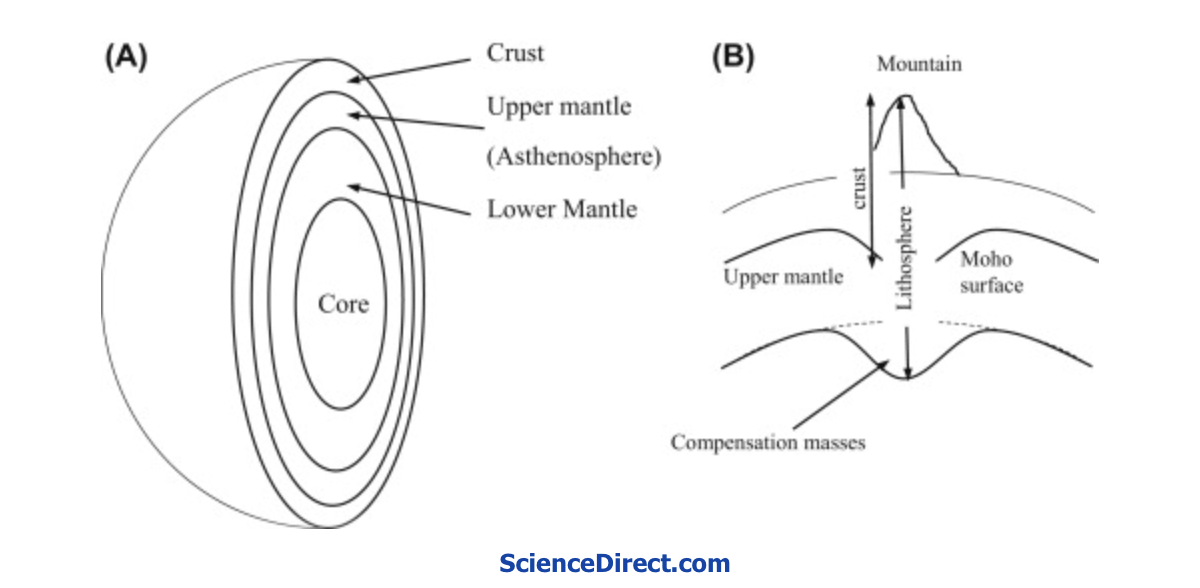
Rheology and the Isostatic Role of Mountains as Described in the Qur’an: Coincidence?
For centuries, the Qur’an has described mountains in a unique way — not just as towering natural formations, but as elements that play a critical role in stabilizing the Earth. In recent times, the science of isostasy has offered a remarkably aligned perspective, describing how mountains contribute to the Earth’s physical balance. This article explores the striking similarity between Qur’anic language and the modern geological understanding of Earth’s crust.
Qur’anic Verses on Mountains and Stability
“And We placed firmly set mountains upon the Earth, so it would not shake with them…”
— Surah Al-Anbiya (21:31)
Quran.com/21/31
“And the mountains as pegs?”
— Surah An-Naba (78:7)
Quran.com/78/7
“And He cast into the Earth firmly set mountains, lest it should shift with you…”
— Surah An-Nahl (16:15)
Quran.com/16/15
These verses clearly describe mountains as being firmly embedded and having a stabilizing function, a field now well-studied under geological rheology — the study of how Earth’s materials deform and flow under stress. The imagery of pegs driven into the Earth is especially powerful and suggestive of deep anchoring.
What Is Isostasy?
Isostasy is a scientific concept that explains how Earth’s crust maintains equilibrium. The crust “floats” on the denser, semi-fluid mantle beneath, much like icebergs float in water. Mountains, being large masses, have deep roots extending into the mantle to maintain gravitational balance.
Read more on isostasy here: ScienceDirect: Isostasy
There are three main models:
- Airy Isostasy: Mountains have deep roots that balance their mass above the surface.
USGS explanation - Pratt Isostasy: Surface elevation varies based on rock density.
Lumen Learning: Crustal Deformation - Flexural Isostasy: The lithosphere bends under weight and redistributes the load.
Geology LibreTexts
In all these models, massive landforms like mountains are key to maintaining the Earth’s vertical and lateral balance.
⚖️ The Qur’an and Isostasy: A Striking Convergence
When the Qur’an describes mountains as “pegs” and says they prevent the Earth from “shaking with you,” it may seem poetic — but it’s far more than that:
- Mountains act like stakes: Geophysically, their roots anchor them deep into the crust, similar to tent pegs stabilizing a tent.
National Geographic – Plate Tectonics and Mountain Roots - They provide mass balance: This deep anchoring helps distribute Earth’s mass and resist vertical movement and crustal deformation.
NASA Earth Observatory – Crust and Mantle - They counteract shifts: In zones of tectonic compression, mountains form in part to relieve and redistribute stress, contributing to long-term crustal stability.
USGS on Orogeny
This mirrors what the Qur’an conveyed using the accessible language of its time: that mountains play a stabilizing role.
Mountains in Motion: Earthquakes and Rebalancing
Some might argue: “But don’t earthquakes happen near mountains?” Yes, they do. But earthquakes are part of the Earth rebalancing itself when isostatic equilibrium is temporarily disrupted. Mountains are not the cause of earthquakes — they are the visible evidence of deep tectonic and isostatic processes working to stabilize the planet over geological timescales.
More on post-glacial rebound and isostatic adjustment:
British Geological Survey
When the Balance Breaks: Isostasy and the Cost of Sudden Change
While isostasy generally maintains Earth’s balance over geological timescales, its failure—or rather, its disruption by sudden changes—can unleash powerful consequences. This is not hypothetical.
Consider the scenario of rapid glacial melt — something increasingly observed in regions like Greenland, Alaska, and Antarctica. Glaciers exert massive downward pressure on the crust. When that weight is suddenly removed due to accelerated melting or evaporation, the crust rebounds upward in a process known as post-glacial rebound.
If this rebound happens too quickly, it can trigger:
- Severe earthquakes in once-stable regions
- Vertical land movement, altering coastlines and affecting infrastructure
- Sea level changes that displace water from one basin to another
- Stress redistribution, potentially reactivating fault lines
What makes this astonishing is how it aligns with the Qur’anic statement that mountains are placed so “the Earth does not shake with you.” (Surah Al-Anbiya 21:31). Without the slow, stable feedback loop of isostasy — often tied to the anchoring function of mountains and thick crust — the Earth would indeed shake more violently and unpredictably.
This isn’t metaphor anymore. It’s observable. And as climate change accelerates glacial melt, we are witnessing, in real-time, how the balance described in the Qur’an becomes a matter of literal geophysical survival.
For detailed geological tracking, refer to:
NASA – Ice Loss and Earth’s Rebound
NOAA – Sea Level Changes
Conclusion
The Qur’an’s description of mountains as stabilizers and pegs is not only metaphorically rich but also scientifically relevant. While the Qur’an doesn’t present a theory of isostasy, leaving it for scientists to study and present to us, its descriptions align uncannily well with what geologists now understand about Earth’s crustal balance.
This convergence between scripture and science does suggest a remarkable depth of expression in the Qur’an — one that continues to resonate with modern understanding.
Mountains, as both natural wonders and structural necessities, affirm a deeper wisdom encoded in both the Earth beneath our feet and the verses that describe it.


